| Description | Participants | Summaries | Products |
|---|
NIMBioS Working Group:
Multiscale Vectored Plant Viruses
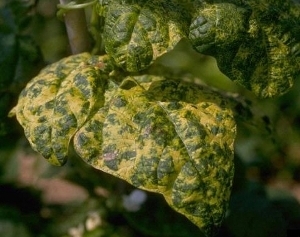
Topic: Multiscale aspects of vector transmission of plant viruses
Meeting dates: Dec 14-16, 2015; Jun 22-24, 2016; Dec 19-23, 2016; Dec 18-20, 2017; Aug 7-9, 2019
Organizers:
Vrushali A. Bokil, Mathematics, Oregon State Univ., Corvallis
Linda J. S. Allen, Mathematics and Statistics, Texas Tech Univ., Lubbock
Alison Power, Ecology & Evolutionary Biology, Cornell Univ.
Objectives: Plant viruses are one of the greatest limiting factors to modern agriculture. The emergence and evolution of plant viruses impact the health and biodiversity of crops and of plants in general, while the continued growth of the human population emphasizes the need for a sustainable agriculture. The problems in vector transmission of plant viruses are not simple; they are multiscale and often are driven by data from specific crops or fields. Given the multiscale nature of the problems (in both time and space), the necessity of involving multiple variables (hosts and pathogens), and the dependence on environmental variables, multidisciplinary teams with expertise in the biology of plants and viruses and in mathematical methods are needed.
This working group will work on current problems related to multiscale aspects of the spatial and temporal transmission and the evolution of vectored plant viruses. The group's goals are to derive novel mathematical, statistical, and computational methods that incorporate multiple hosts and multiple pathogens operating at varying spatial and temporal scales to bring insight into the effects of climate change and human activities on the emergence of new plant viruses. We will consider some of the most challenging problems in plant disease ecology, to advance the field of vectored plant viruses and provide a better understanding of effective methods for control of plant viral diseases in crops and natural systems.
Ideas for this working group benefited from discussions at the NIMBioS Investigative Workshop on Vectored Plant Diseases, organized by L. J. S. Allen, V. A. Bokil, E. T. Borer, and A. Power, March 17-19, 2014.

Meeting Summaries
| Mtg # | Dates | Agenda | Summary | Photo | Evaluation |
|---|---|---|---|---|---|
| 1 | Dec 14-16, 2015 | Link | Link | Report | |
| 2 | Jun 22-24, 2016 | Link | Link | ||
| 3 | Dec 19-23, 2016 | Link | Link | ||
| 4 | Dec 18-20, 2017 | Link | Link | ||
| 5 | Aug 7-9, 2019 | TBA | Link | TBA |
Meeting 1 Summary. Several short talks were given on seed degeneration, within-host and between-host models and multiple spatial scales. After brainstorming and extensive discussion, two topics were selected for this first meeting: (1) integrating within-host, between-host models and (2) individual-based and network approaches to address specific biological questions concerning diseases of agricultural importance. Discussions on the first topic led to formulation of a preliminary within-host, between-host model for plant-vector-virus systems with a goal to address cases where explicit vector dynamics or within-host modeling play important roles. Discussions on the second topic led to identification of an agricultural disease of recent origin, maize lethal necrosis (MLN), which is a threat to food security in Sub-Saharan Africa. MLN is incited by coinfection of the Maize chlorotic mottle virus and any of a number of potyviruses. A preliminary outline of a paper and a simple mathematical model for MLN were formulated. The future goals are (1) to continue working on a draft of a paper for MLN with data from Africa to parameterize the model and to compare potential model outcomes from different control scenarios and (2) to update and improve the within-host, between-host model.
Meeting 2 Summary. During the second meeting, progress was made on a model for maize lethal necrosis (MLN), a disease resulting from coinfection of maize crops with Maize chlorotic mottle virus (MCMV) and a potyvirus such as Sugarcane mosaic virus (SCMV). Advice on MLN from an expert external advisor from USDA and data analyses of a single infection versus coinfection with SCMV or MCMV led to further insight into model formulation. A new semi-discrete model with seed, soil and implicit vector transmission was formulated. Extensions of the model and multiscale approaches to plant vectored viruses were discussed and will be investigated in subgroups. The working group decided to focus their immediate efforts on a joint publication on MLN which emphasizes scenarios of interest to localities within Africa and South America, where MLN is an emerging disease. A preliminary working draft of a paper has been outlined and tasks have been assigned to group members to ensure a timely submission of the manuscript for publication.
Meeting 3 Summary. During the third meeting, considerable progress was made toward completion of a manuscript on a coinfection model and its analysis for the spread of maize lethal necrosis (MLN), a disease resulting from coinfection of maize crops with Maize chlorotic mottle virus (MCMV) and a potyvirus such as Sugarcane mosaic virus (SCMV), an emerging plant disease in Kenya. The Working Group focused on management options such as crop rotation, insect control, use of virus-free seed, or removal of infected plants applicable to large commercial farms or to small farms. After subsequent Zoom meetings during January and February 2017, the paper was completed and submitted to the Phytopathology Focus Issue 2017 on Epidemiology: Past, Present and Future Impacts on Understanding Disease Dynamics and Improving Plant Disease Management. This manuscript represents the first modeling papers on MLN. It has now been accepted for publication and is available online. A press release was distributed by NIMBioS. The group also identified potential topics for a fourth meeting at NIMBioS.
Meeting 4 summary: Participants met to tackle two main areas of research stemming from the group's previous work with mathematical models of co-infection: 1) incorporation of grower behavior and 2) understanding the various routes of transmission of vectored plant diseases that lead to bistability. Progress was made on four projects related to the two identified areas of research. The first project proposed a model to understand the prevalence of coinfection under independent virus dynamics. Numerical simulations will be tested against empirically derived data. The second project investigates how coinfection drives bistability through vertical or horizontal transmission and removal or recovery of individuals. The third project unites aspects of the first two projects to explore how the diversity of vectors affects coinfection levels and the bistability phenomenon. The final project used the model originally created during prior working group meetings (Hilker et al 2017, Phytopathology) as a framework for applying economic theory of risk-reward to evaluate changes in grower behavior. Subsequent Zoom meetings will continue progress on these models.
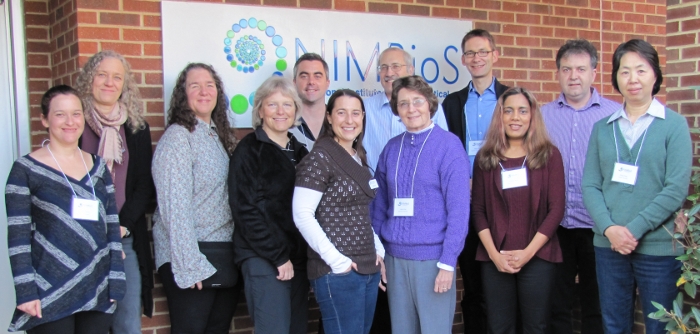
|
| Meeting 1 participants (L to R): Carrie Manore, Alison Power, Karen Garrett, Cherie Briggs, Frederic Hamelin, Megan Rúa, Louis Gross, Linda Allen, Frank Hilker, Vrushali Bokil, Nik Cunniffe, Zhilan Feng. |

|
| Meeting 2 participants. (Back Row, L to R): Karen Garrett, Alison Power, Frederic Hamelin, Frank Hilker, Linda Allen, Nik Cunniffe, Louis Gross; (Front Row, L to R): Vrushali Bokil, Cherie Briggs, Megan Rúa, Carrie Manore. |
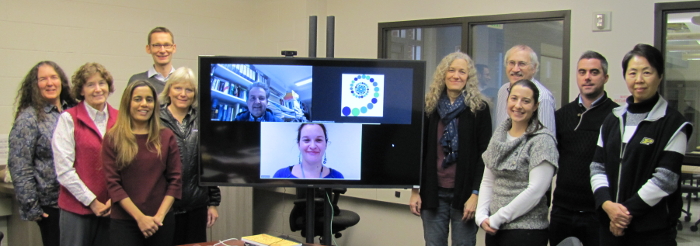
|
| Meeting 3 participants (L to R): Karen Garrett, Linda Allen, Vrushali Bokil, Frank Hilker, Cherie Briggs, Nik Cunniffe (virtual), Carrie Manore (virtual), Alison Power, Louis Gross, Megan Rúa, Frederic Hamelin, Zhilan Feng. |
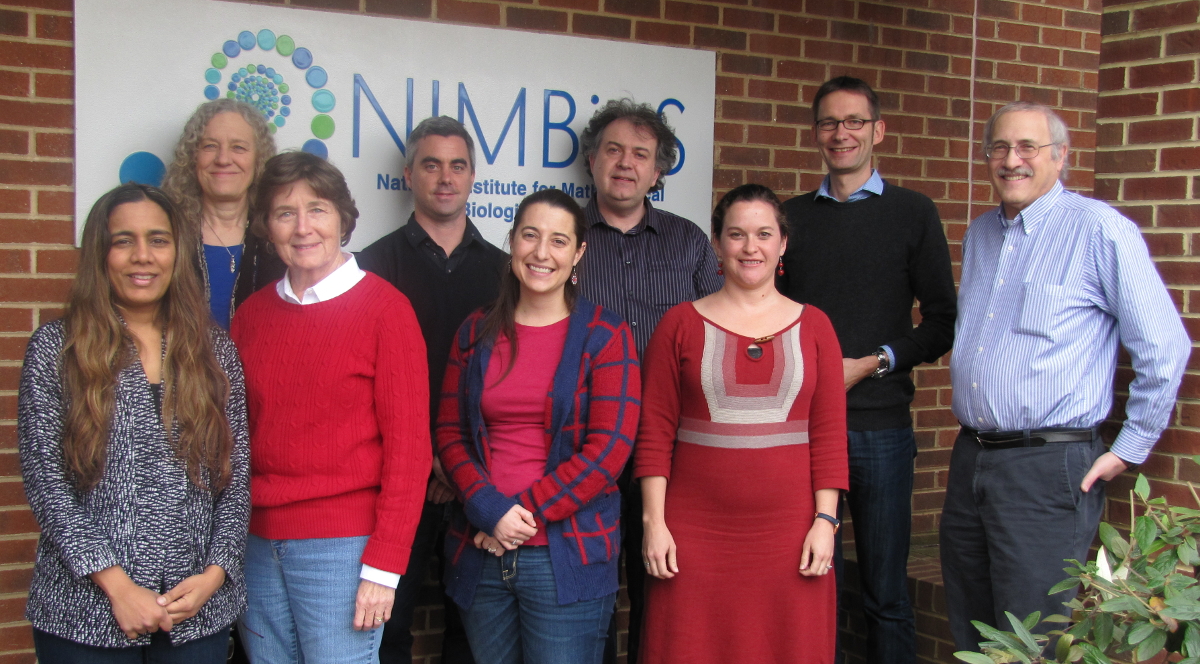
|
| Meeting 4 participants (L to R): Vrushali Bokil, Alison Power, Linda Allen, Frederic Hamelin, Megan Rúa, Nik Cunniffe, Carrie Manore, Frank Hilker, Louis Gross. |
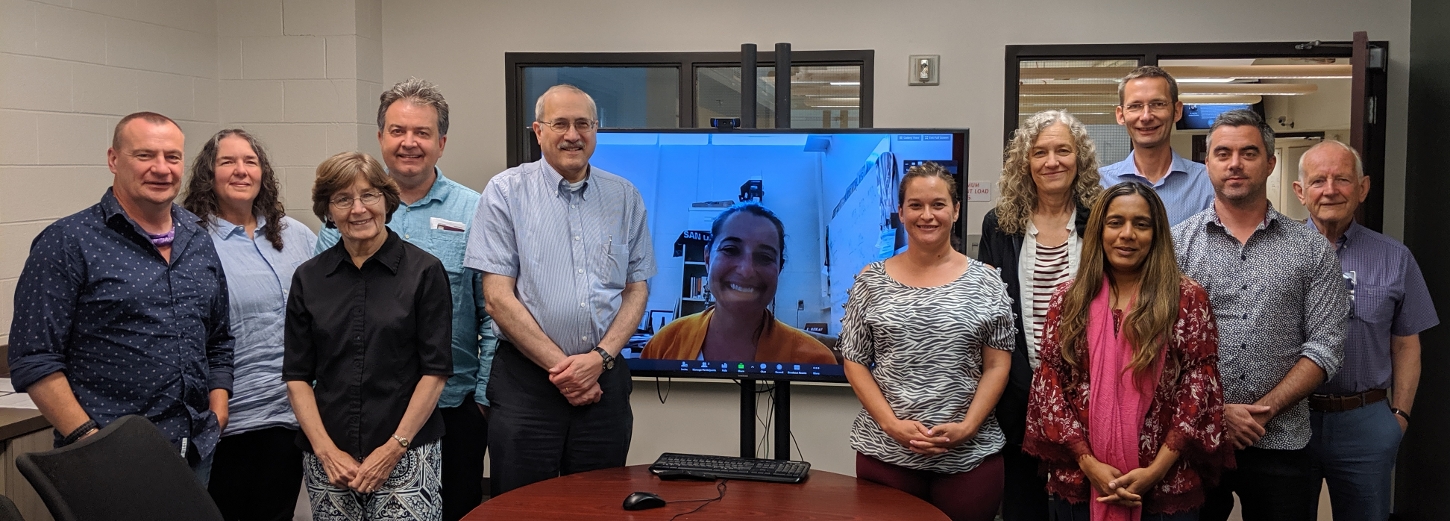
|
| Meeting 5 participants (L to R): Neil McRoberts, Karen Garrett, Linda Allen, Nik Cunniffe, Louis Gross, Megan Rúa (virtual), Carrie Manore, Alison Power, Vrushali Bokil, Frank Hilker, Frederic Hamelin, Michael Jeger. |
NIMBioS Working Groups are chosen to focus on major scientific questions at the interface between biology and mathematics. NIMBioS is particularly interested in questions that integrate diverse fields, require synthesis at multiple scales, and/or make use of or require development of new mathematical/computational approaches. NIMBioS Working Groups are relatively small (up to 10 participants), focus on a well-defined topic, and have well-defined goals and metrics of success. Working Groups will meet up to 3 times over a two-year period, with each meeting lasting up to 2.5 days.
A goal of NIMBioS is to enhance the cadre of researchers capable of interdisciplinary efforts across mathematics and biology. As part of this goal, NIMBioS is committed to promoting diversity in all its activities. Diversity is considered in all its aspects, social and scientific, including gender, ethnicity, scientific field, career stage, geography and type of home institution. Questions regarding diversity issues should be directed to diversity@nimbios.org. You can read more about our Diversity Plan on our NIMBioS Policies web page. The NIMBioS building is fully handicapped accessible.
NIMBioS
1122 Volunteer Blvd., Suite 106
University of Tennessee
Knoxville,
TN 37996-3410
PH: (865) 974-9334
FAX: (865) 974-9461
Contact NIMBioS


